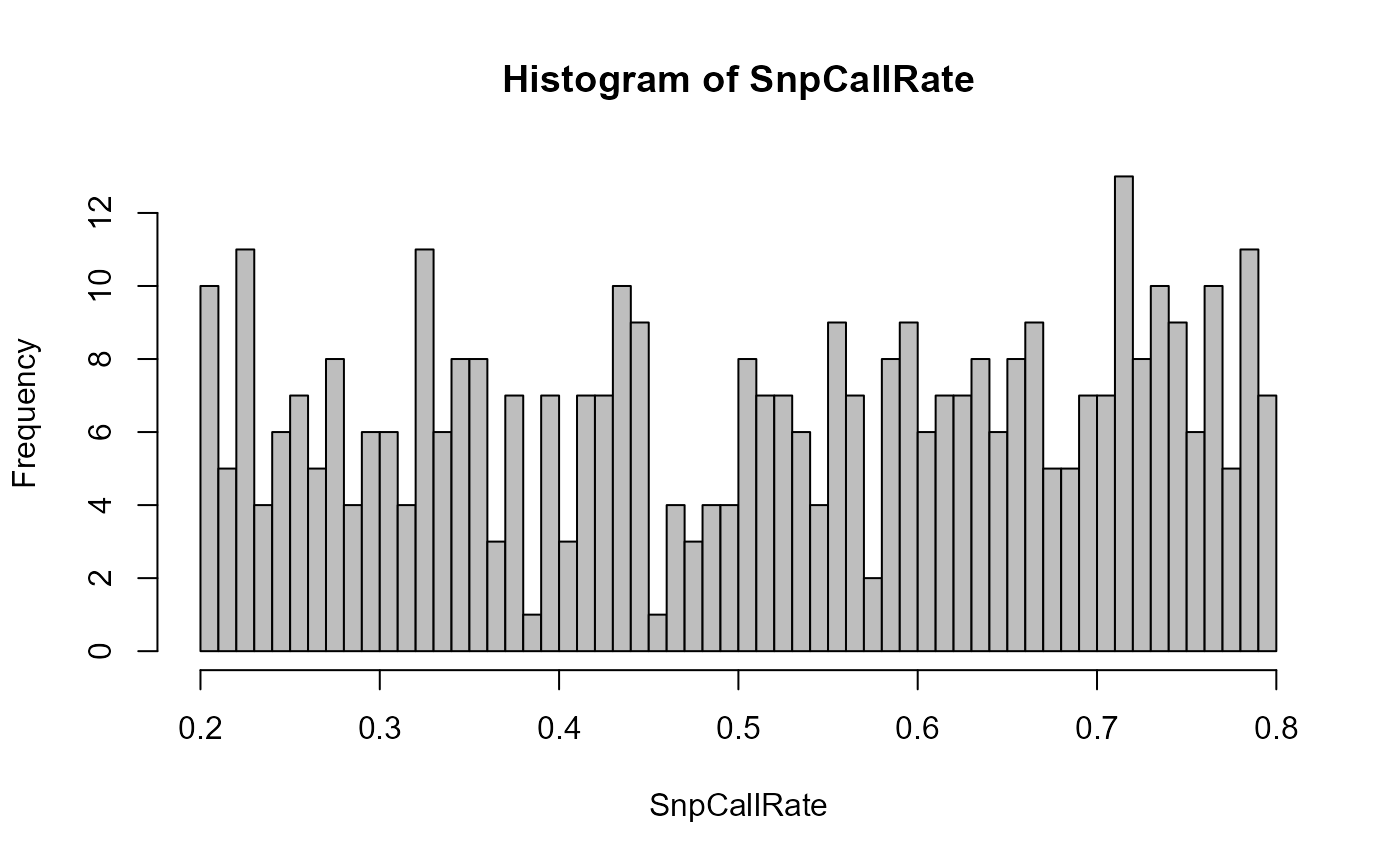Check Genotype Matrix
CheckGeno.RdCheck that the provided genotype matrix is in the correct format, and check for low call rate samples and SNPs.
Usage
CheckGeno(
GenoM,
quiet = FALSE,
Plot = FALSE,
Return = "GenoM",
Strict = TRUE,
DumPrefix = c("F0", "M0")
)Arguments
- GenoM
the genotype matrix.
- quiet
suppress messages.
- Plot
display the plots of
SnpStats.- Return
either 'GenoM' to return the cleaned-up genotype matrix, or 'excl' to return a list with excluded SNPs and individuals (see Value).
- Strict
Exclude any individuals genotyped for <5 genotyped for <5 up to version 2.4.1. Otherwise only excluded are (very nearly) monomorphic SNPs, SNPs scored for fewer than 2 individuals, and individuals scored for fewer than 2 SNPs.
- DumPrefix
length 2 vector, to check if these don't occur among genotyped individuals.
Value
If Return='excl' a list with, if any are found:
- ExcludedSNPs
SNPs scored for <10 excluded when running
sequoia- ExcludedSnps-mono
monomorphic (fixed) SNPs; automatically excluded when running
sequoia. This includes nearly-fixed SNPs with MAF \(= 1/2N\). Column numbers are *after* removal ofExcludedSNPs, if any.- ExcludedIndiv
Individuals scored for <5 reliably included during pedigree reconstruction. Individual call rate is calculated after removal of 'Excluded SNPs'
- Snps-LowCallRate
SNPs scored for 10 recommended to be filtered out
- Indiv-LowCallRate
individuals scored for <50 recommended to be filtered out
When Return='excl' the return is invisible, i.e. a check
is run and warnings or errors are always displayed, but nothing may be
returned.
Thresholds
Appropriate call rate thresholds for SNPs and individuals depend on the total number of SNPs, distribution of call rates, genotyping errors, and the proportion of candidate parents that are SNPd (sibship clustering is more prone to false positives). Note that filtering first on SNP call rate tends to keep more individuals in.
Examples
GenoM <- SimGeno(Ped_HSg5, nSnp=400, CallRate = runif(400, 0.2, 0.8))
# the quick way:
GenoM.checked <- CheckGeno(GenoM, Return="GenoM")
#> ! There are 191 SNPs scored for <50% of individuals
#> ℹ There are 1000 individuals and 400 SNPs.
# the user supervised way:
Excl <- CheckGeno(GenoM, Return = "excl")
#> ! There are 191 SNPs scored for <50% of individuals
#> ℹ There are 1000 individuals and 400 SNPs.
GenoM.orig <- GenoM # make a 'backup' copy
if ("ExcludedSnps" %in% names(Excl))
GenoM <- GenoM[, -Excl[["ExcludedSnps"]]]
if ("ExcludedSnps-mono" %in% names(Excl))
GenoM <- GenoM[, -Excl[["ExcludedSnps-mono"]]]
if ("ExcludedIndiv" %in% names(Excl))
GenoM <- GenoM[!rownames(GenoM) %in% Excl[["ExcludedIndiv"]], ]
# warning about SNPs scored for <50% of individuals ?
# note: this is not necessarily a problem, and sometimes unavoidable.
SnpCallRate <- apply(GenoM, MARGIN=2,
FUN = function(x) sum(x!=-9)) / nrow(GenoM)
hist(SnpCallRate, breaks=50, col="grey")
 GenoM <- GenoM[, SnpCallRate > 0.6]
# to filter out low call rate individuals: (also not necessarily a problem)
IndivCallRate <- apply(GenoM, MARGIN=1,
FUN = function(x) sum(x!=-9)) / ncol(GenoM)
hist(IndivCallRate, breaks=50, col="grey")
GenoM <- GenoM[, SnpCallRate > 0.6]
# to filter out low call rate individuals: (also not necessarily a problem)
IndivCallRate <- apply(GenoM, MARGIN=1,
FUN = function(x) sum(x!=-9)) / ncol(GenoM)
hist(IndivCallRate, breaks=50, col="grey")
 GoodSamples <- rownames(GenoM)[ IndivCallRate > 0.8]
GoodSamples <- rownames(GenoM)[ IndivCallRate > 0.8]